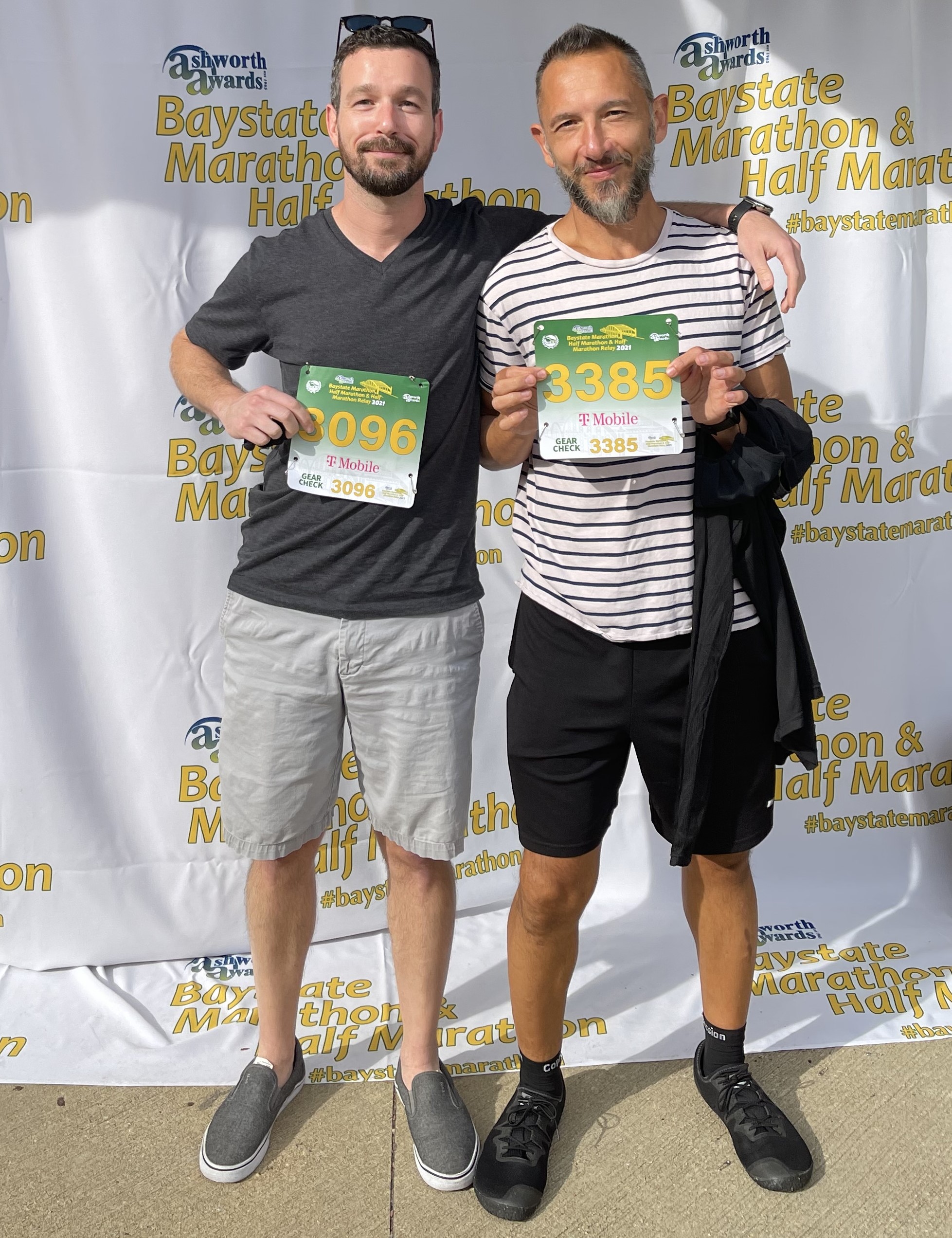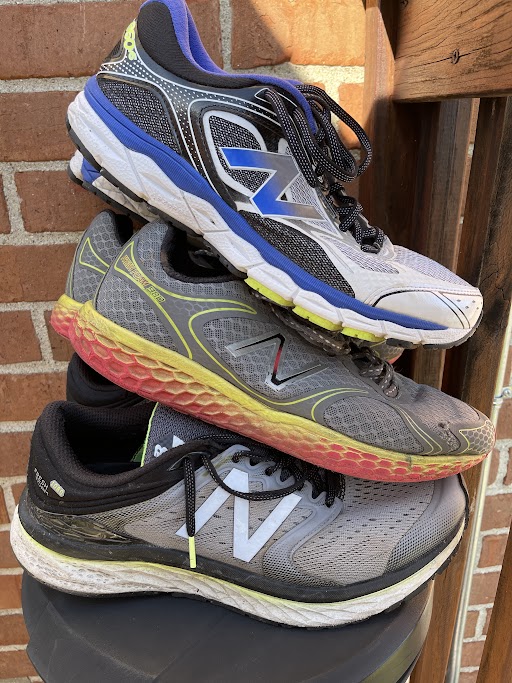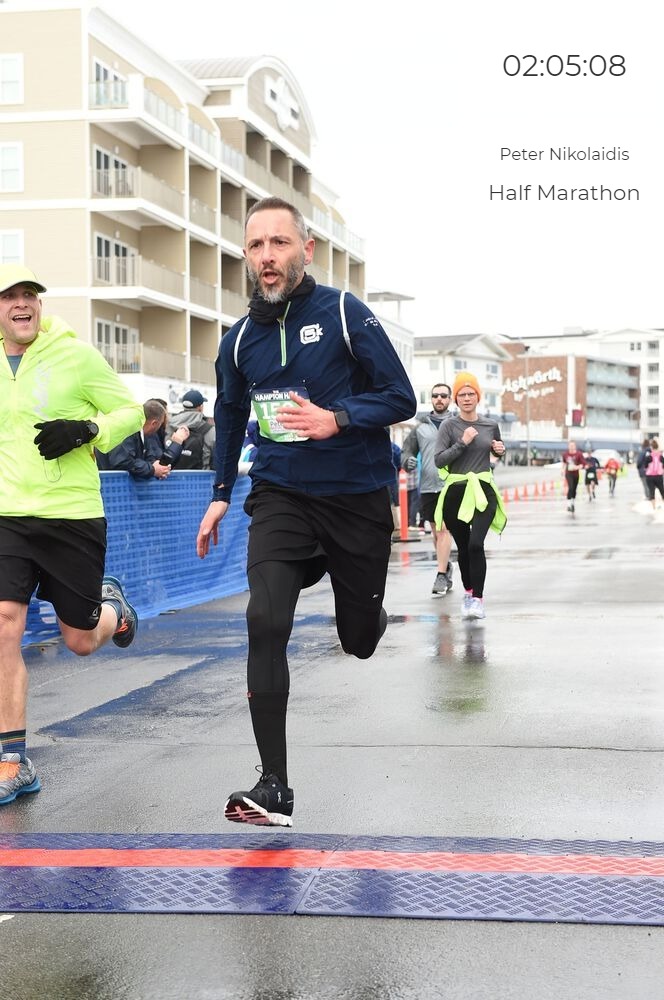A few days after my first marathon last year, my right foot swelled up. Massively. I took a couple days off, and did (relatively) short runs. The foot hurt and would swell up like a baloon. I self-diagnosed as having a stress injury (fracture?) and accepted I may have to stop running for the rest of the year. I was able to get an appointment with a sports orthopedist at MGH, and he prescribed physical therapy. X-Rays showed no (remaining) fractures.
My First Marathon
I did it. Four hours and 38 minutes of nearly non-stop plodding along at an average 10:37/mile pace. My main goal was to finish in 4.5 hours. My secondary goal was to finish. I finished. 690 people finished the marathon. I was 575. So hey! I was in the top 83rd percentile!

You Don’t Need Running Shoes. Go Minimalist!

From 2017 to early 2021, my go to running shoes were the New Balance Fresh Foam 1080 (I forget if they were version 9 or 10), and a pair of the New Balance Summit Unknown for trail running. In 2020 I went on a bit of a shopping spree and was trying all sorts of New Balance shoes, as I liked the wide toe box that didn’t mash my feet. I had an old pair of the Fresh Foam 960s, and bought a pair of the Fresh Foam 980s, as well as the Fresh Foam More. I liked my shows like I like my cappuccino – fresh and foamy.
Or so I thought.
Continue reading “You Don’t Need Running Shoes. Go Minimalist!”33rd Annual Baystate Marathon
It’s been a while since I threw my hat over the fence, so here we go! I just registered for the 33rd annual Baystate Marathon. 26.2 miles of pure fun in the tradition of my Spartan ancestors*. I started running regularly in 2017, and embraced it in 2018. In March 2020 I ran 13.1 miles for the first time. I did 13.25 three weeks ago, then 14 last weekend. Sunday my running buddy/accountability partner and I will do 15.5, etc., as we build up to the event on October 17. The clock is ticking!
I have no goal other than to finish. I think that’s sufficient for now.
* No, I don’t really know if I had any Spartan ancestors, but my dad’s from Athens, so that’s close, right?
How to Not Look Dumb in Online Meetings
If you’re like 99% of the civilized world, you’ve been on a Zoom, WebEx, GotoMeeting, Hangout, Meet, or other similar platform within the last two hours. Even though it’s been just over a year since the first reported case of COVID-19 in the US, I figured it would not hurt to give some folks some best practices on attending online meetings.
Know if Your Camera is On
I recommend cameras on for small meetings. It shows that you are (or are not) engaged. For a large meeting with dozens of people in attendance, don’t turn your camera on if no one else has – just go with the flow. If you’re a manager and you want people to be more engaged, have your staff turn ’em on.
If your camera is on, act accordingly. Don’t be that guy.
Mute if You’re Not Speaking
If you’re a good meeting attendee, and you’re paying attention to what’s going on, you may not need to mute. However, if you’re splitting your attention, typing, using a scratchy microphone, or have background noise (kids, spouses, pets, traffic, smoke detectors, etc.) please mute. And then remember to unmute when you speak. Another reason to keep your camera on – if you forget to unmute, people can helpfully tell you “you’re muted.”
Use a Good Microphone
Lots of people have cheap headsets or use their laptop microphone. Some of these sound absolutely terrible. If your microphone is the kind that hangs by your neck, you’ll likely make a sound like steel wool over a chalkboard every time you turn your head. Laptop mics also tend to have a lot of echo and can sound like you’re very far away. Using your phone for audio is often better. Amazing! A device built for audio calls is better at audio. Most platforms offer an iOS and Android option, and these will usually let you call in over the Internet and via a phone call. Try these if anyone complains of audio quality issues when you’re using a laptop microphone. And if other people on the meeting are complaining about your audio quality, do something about it. Don’t ignore it or just hope it gets better.
Use Do Not Disturb
Another annoyance is the constant buzz or beep of notifications going off in the background. Enable do not disturb or sign out of your email and messaging platforms.
Share Only What You Want
If you’re presenting, share only the application you want everyone else to see. This is safe than sharing your entire screen. Showing up nude when your camera is on is pretty bad. Slightly less embarrassing is getting a pop-up on your screen about how stupid someone else in the meeting is.
3 Must-Use Commands With Tupperbox in Discord
For the last few months, I’ve been using Discord, Slack, Hangouts, Signal, Skype, and Teams for chatting with friends, family, colleagues, and clients. Discord is very like Slack, with a few differences because it’s geared toward gamers while Slack focuses on businesses.
Both Slack and Discord support add-ons in the form of ‘bots (robots, or programs that watch for certain events and respond to them). Tupperbox is a robot that has popped up on a couple of servers on which I role-play. It’s used to let you assign actions to issue different responses, based on the inputs. In my most frequent use case, I give it a trigger phrase and it takes whatever follows and makes the text appear to have come from someone else. I can use the robot to make a sentence I type look like it came from one of my characters instead of myself. Instead of “Peter Nikolaidis says that Hector Roundtree says ‘Forsooth!'” you would see “Hector Rountree: ‘Forsooth!'”
The trick is that I need to register every character and its associated trigger phrase, and this confuses me every time, despite the built in help. So I figured I’d document the exact characters I typed right here for next time (and for you, of course, dear reader)!
How register a new character/avatar/name:
tul!register "Hector Roundtree" hrtext
Any time I start a message with the letters “hr” and repackage anything after that to appear to have come from “Hector Roundtree” himself.
I also like to have a different icon for each of my characters. The first step is to upload a small (thumbnail) image, preferably a square with the face in the center, to a publicly reachable URL. I’ve had zero luck linking to OneDrive or iCloud photos, so I upload them to my WordPress site and reference them from there.
tul!avatar "Hector Roundtree" https://example.com/uploads/images/hector-roundtree.png
The above text will register the image with posts made by Sir Hector, instead of a big question mark icon.
Update: Another option I only recently discovered is to drag and drop the avatar picture right into the post, instead of giving a URL. This is a much simpler option!
What if you goof and want to start over? You can always remove and re-register. For example, I registered “JJ:” for one of my characters, and “hr” for another. The problem? For one, the colon is extraneous. I could use “JJ” instead. Also case matters, so “JJ” is not the same as “jj” or “Jj.” I often type posts from my phone, which likes to autocorrect things. For instance, if I start a new post by typing a letter ‘h’ and an ‘r’ by default this will be “Hr.” Great, except I registered “hr” so every time I want to post as Hector, I have to uncapitalize the ‘H’ first. What a pain! That’s where the remove command comes in.
tul!remove "Hector Roundtree"
The above text will remove Hector, letting me re-add him with a simpler trigger phrase. This time I’ll use “Hr” to make for easier posting from my phone.
tul!register "Hector Roundtree" Hrtext
My Journey Into Analyzing Apple Health Data
I’ve owned an Apple Watch for years – since the Series 2. I’ve also been running consistently for years – three of them, to be precise. I also like data. I’ve been collecting data on my workouts via my phone and watch for years, but getting data off of the iPhone’s small screen has always been problematic.
“But Peter!” you say “Apple lets you export data from the Health app!” Yes, it does. Have you ever looked at it? It looks something like this. Correction – it looks EXACTLY like this.

It’s XML data, and that doesn’t easily lend itself to a graph. Also, my data is over 1.3GB at present. That’s a lot of data for one guy. So I looked around for how to analyze my iOS Health data. The first site I found that looked promising was Analyze the Crap Out of Your Apple Health/HealthKit Data (sep.com) and GitHub – jonfuller/health-parse: Parses an Apple Health data export… for reasons. The developer offers an email address – email your health data to [email protected] and it will send back parsed stuff. Sure. I’ll email you my 1.3GB of Apple Health Data. Let me know when you get it. Okay, no, I did not try that because it’s never going to work. So I downloaded his code from Github, but I couldn’t get it to compile. Seems like I’m not the only one, as others reported the same issue.
Next I tried the Heartwatch app for iOS. So close! It generates some nice reports but only goes back one year. I want to track data over multiple years. I emailed the developer, and he said he’d consider it.
Then I tried the YouTube video (1) How to download, graph and assess physical activity and exercise data from Apple Watch – YouTube. OMG hilarious. Fail.
Something in Python perhaps? Analyze Your iOS Health Data With Python | by Guido Casiraghi | Better Programming | Medium Prerequisites: You know the basics of Pandas. I don’t even know what pandas is, other than a big bear-like thing that lives in China.
I tried to import the XML files into Excel. Hahahaha. I’m running the 32-bit version. It cannot open a 1.3GB XML file.
I poked around and found this article by Taras Kaduk: Analyze and visualize your iPhone’s Health app data in R. I was told R is easy to learn and use, so I figured I’d give it a try.
I installed R for Windows. The UI seems a bit dated and barebones. The Comprehensive R Archive Network (case.edu) How do I install libraries, anyway? HodentekHelp: How do you install the XML library for R programming? Okay, manual process, must select stuff from a list by point and click. Yuck.
How do I change directories in R? how to set path in R on Windows – Google Search
Hm. This looks kinda neat and more polished. Download the RStudio IDE – RStudioHave to install those libraries, but at least I can type their names in a comma-separated list. Much quicker.
How do I change directories in R again? getwd, setwd | R Function of the Day
What’s the path to my files in my OneDrive folder without spaces in it? Use PowerShell to display Short File and Folder Names | Scripting Blog (microsoft.com)
How do you comment in R? Comments in R – GeeksforGeeks
How do you print more lines than it’s showing me? how to increase the limit for max.print in R – Stack Overflow
What does that %>% do? Simplify Your Code with %>% · UC Business Analytics R Programming Guide (uc-r.github.io)
Oof. Guess I should take a lesson. Learn R | Codecademy
Yup, that did it! The following R code imports my Health XML data and spits out a CSV. And yeah, it took a lot of floundering to get these few lines of code:
library(XML)
library(dplyr)
xml <- xmlParse('export.xml')
df_workout <- XML:::xmlAttrsToDataFrame(xml["//Workout"])
write_csv(df_workout,'health_export.csv')
Now I have a CSV file! Great! I’ll make a chart in Excel. OMFG Excel charting is beyond convoluted. Why is it so F***ING COMPLICATED?!?!
Google Sheets to the rescue. Finally. I have what I have sought for months.

I realized that with the right libraries, I likely could have accomplished the same thing with Perl or Python, but learning R has been fun and I may have applications for this professionally as well as personally. Also, I should be able to generate the graphs directly from R, but haven’t learned that yet. Finally, I will likely need to dive deeper into the data to incorporate steps per minute and heartrate into the above chart. I’m really interested in overlaying my steps per minute and average heartrate to see how this affects energy used and pace. So while I’ve taken the first step (no pun intended), I’m not done yet!
How to Hold Your Foot in a Strap With Minimal Effort
I like to use a strap in leg extensions, especially in long-held Yin poses. The problem? Holding the strap gets tiring! Looping it around the fingers can hurt after a while, and even if you hold it around the meaty part of the hand, it still takes some muscle power.
The solution? Loop the strap around both wrists so that it holds itself in place. Start by making a loop. 
Take the bottom of the loop and lift it toward its center so as to make two smaller loops toward the bottom. 
Slide your hands through the small loops. 
Grasping the strap, loop it over your foot, so that your hands rest lightly on the strap and are held in place by it. 
Recline, extend, and relax!
Here’s a video where I walk through the process.
Focus
Inspired by a newsletter email from the folks at RescueTime, I’ve decided to give single-tasking another shot. Hopefully my meditation training will help. In recent months, I’ve noticed an increasing tendency to get distracted while – wait for it – multitasking. Despite having known this was a bad practice for years, I still find myself doing it. Well, I’m going to work on fixing this – again. The last time I did so was quite some time ago. Here are some tricks I’ll be trying.
- Less playing of podcasts in the background for “background noise.”
- Fewer windows open at once. So much for those investments in all those big flat panel displays.
- Taking one on one calls with my reports on my phone as opposed to on a computer, and insisting they do the same.
- Closing all those extra tabs and getting back to checking email on a schedule (except of course if I’m on call and need to be responsive in a more timely fashion).
Got any other tips or tricks? Let me know!
180 Steps Per Minute
On my last two 10k runs, I experimented with upping my cadence (steps per minute). My normal cadence has been in the 155-165 steps per minute, and my normal pace has usually been in the high 9 to low 10 minutes per mile. This is mainly because I haven’t really cared to address my speed, so I would just ramble on at whatever pace I felt like running at, unless I was in a hurry or with someone else.
While I had heard that my pace “should be 180 steps per minute,” it was never clear to me as to why this was important. Additionally, given my training in yoga and anatomy, in which a recurring theme was “ever body is different,” how could it be that these two guys should be expected to have the same cadence?


No, really. How can that make any sense? It should not be a surprise that there is some room for variation here, as with all things anatomy, and 180 is likely just an average. That said, I figured “what the heck? Why not give it a try.” After a little digging I found a website that suggested working your way up to 180 by starting with a playlist that runs around 10 bpm faster than your current average cadence. So I found a playlist on Apple Music that ran at 165 bpm, and I hit the road.
I immediately felt like I was moving faster – and I was. At first it was definitely more work, but after a while, I got into a rhythm. On a funny note, I found out after I finished my run that I had averaged 182 steps per minute! I knew that I was not keeping time with the beat of the music, but I didn’t realize it was because I was going too fast. Given that, I picked another playlist, this time running at 180 bpm. On my second attempt at keeping this cadence, I actually was a bit slower, coming down to the mid 170s on average. That said, it was still one of my fastest – if not the fastest – 10k I’ve done, coming in with an average of 8’59”.
In short, I’m sold. I’m going to try to keep up with the 180 steps per minute cadence. Supposedly this is universal, and applies to all forms of terrain. Time will tell as I experiment. Watch this space for an update!

